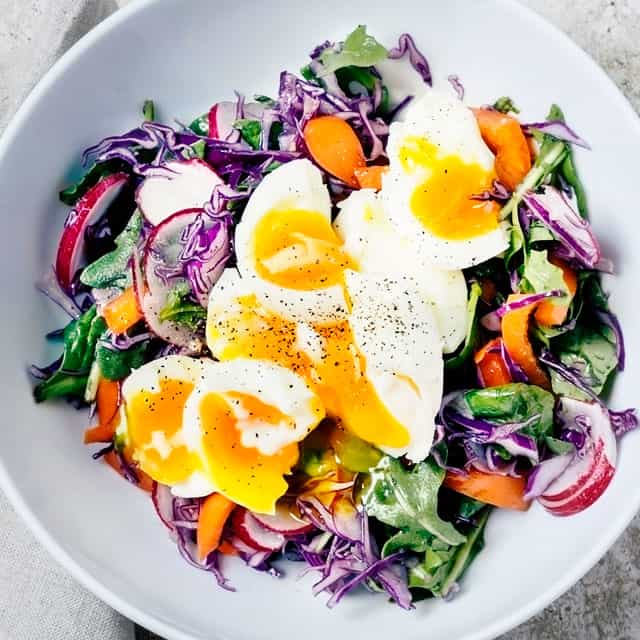 Before you make any changes to your diet, be sure to consult your physician because every body needs something different!
Before you make any changes to your diet, be sure to consult your physician because every body needs something different!
The Paleo diet is pretty simple—eat like early humans from the Paleolithic period. Grains are omitted because humans didn’t start cultivating them until about 10,000 years ago, significantly more recent than the Paleolithic era. Vegetables, fruits, nuts and seeds, as well as lean meat, poultry, fish and seafood are all a part of the basic Paleo diet.
What Not to Eat on a Paleo Diet
Besides grains, like wheat, barley, oats, etc., what else will you want to avoid while eating Paleo? Beans and potatoes are out for similar reasons to grains. Although, many people include sweet potatoes but not white potatoes in the Paleo diet. Similarly, dairy and processed sugars are not a part of the Paleo diet either. Of course, processed foods aren’t permissible. But don’t worry, this still leaves lots of delicious foods for you to enjoy!
Paleo Diet Benefits
One of the great benefits of the Paleo diet is boosting the amount and variety of your daily fruit and veggie intake which naturally increases the amount of nutrients and anti-oxidants you’re getting. Sugar has been linked to many health issues, eliminating it from your diet is another plus of going Paleo.
Ready to delve deeper?
We have more paleo-related resources on our website!
Written by blogger Cheryl Malik at
40 aprons.com, the article
How to Go Paleo touches on topics like creating a Paleo recipe bank, getting support while starting your new routine and stocking your pantry for your new Paleo endeavor. In
Stocking a Paleo Pantry, Cheryl hands you your Paleo shopping list for those must-have in Paleo planning. She even wrote about her
Top Paleo Products at Sprouts.
In the article
What is Paleo? you’ll learn more about the nutritional value of the fruits and veggies, as well as great snacks and a recipe for grilled lamb chops!
Another great resource for planning your Paleo shopping list is
Top Five Paleo Substitutions by our blogger friend, Emily Sunwell-Vidarri, at
RecipesToNourish.com. She explores substitutions for fats, baking ingredients, non-dairy milks, natural sweeteners and even rice on the Paleo diet plan.
Did you know? Despite the fact that the Paleo diet is trending now, it was actually developed by a gastroenterologist named Walter Voegtlin in the 1970s!
 Before you make any changes to your diet, be sure to consult your physician because every body needs something different!
The Paleo diet is pretty simple—eat like early humans from the Paleolithic period. Grains are omitted because humans didn’t start cultivating them until about 10,000 years ago, significantly more recent than the Paleolithic era. Vegetables, fruits, nuts and seeds, as well as lean meat, poultry, fish and seafood are all a part of the basic Paleo diet.
Before you make any changes to your diet, be sure to consult your physician because every body needs something different!
The Paleo diet is pretty simple—eat like early humans from the Paleolithic period. Grains are omitted because humans didn’t start cultivating them until about 10,000 years ago, significantly more recent than the Paleolithic era. Vegetables, fruits, nuts and seeds, as well as lean meat, poultry, fish and seafood are all a part of the basic Paleo diet.
 Before you make any changes to your diet, be sure to consult your physician because every body needs something different!
The Paleo diet is pretty simple—eat like early humans from the Paleolithic period. Grains are omitted because humans didn’t start cultivating them until about 10,000 years ago, significantly more recent than the Paleolithic era. Vegetables, fruits, nuts and seeds, as well as lean meat, poultry, fish and seafood are all a part of the basic Paleo diet.
Before you make any changes to your diet, be sure to consult your physician because every body needs something different!
The Paleo diet is pretty simple—eat like early humans from the Paleolithic period. Grains are omitted because humans didn’t start cultivating them until about 10,000 years ago, significantly more recent than the Paleolithic era. Vegetables, fruits, nuts and seeds, as well as lean meat, poultry, fish and seafood are all a part of the basic Paleo diet.

 VIEW ALL
VIEW ALL



